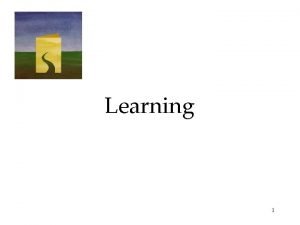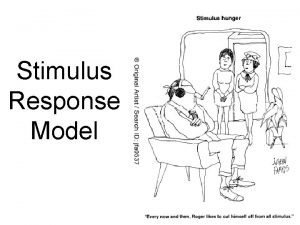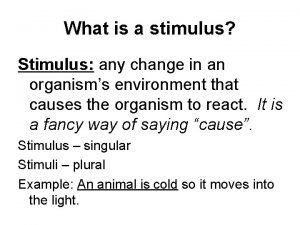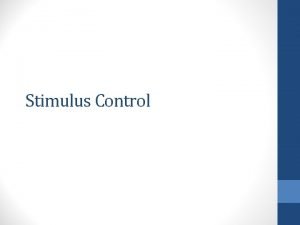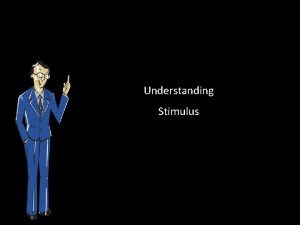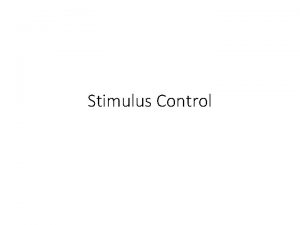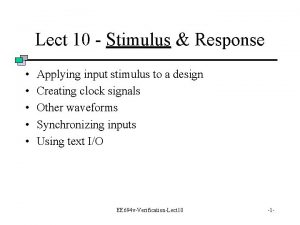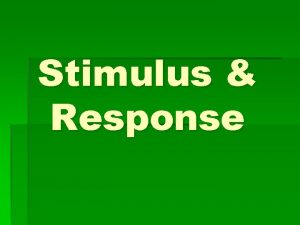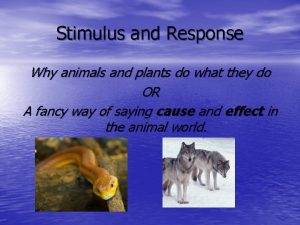Growth and development in plants Response Stimulus n











- Slides: 11

Growth and development in plants

Response Stimulus n Results in survival of species n respond by changing their growth pattern n Tropism – growth toward or away from a unidirectional stimulus, toward +, away Phototropism - light n Gravitropism - gravity n Thigmotropism – touch n n Reception transduction response

Nastic movements n Movements that do not involve growth, not dependent on direction of stimulus n Seismonastic movements – touching, shaking, light or thermal stimulation n n Mimosa plant, prayer plant Changes in turgor pressure, K+ Circadian rhythm – biological rhythm with 24 hours cycle n Biological clock – mechanism by which the biological rhythm is maintained n

Plant Hormones n Chemical signals produced in very low concentrations for communication

Auxin n affect many aspects of plant growth and development n Indoleacetic acid(IAA) most common occurring n Apical dominance – prevents lateral buds n Promotes root growth if applied n Promotes growth of fruit n Induce development of fruit without pollination n Weed control (Agent Orange) n Gravitropism and phototropism nd messengers lead to n moves to shady side, 2 production of growth factors, elongation of stem on shady side, bends toward light

Gibberellins n Growth promoting hormones n Gibberellic acid (GA) n Stem elongation (bush beans to pole beans) n Used to break dormancy, bring on onset of flowers n Induce growth of plants and increase size of flowers

cytokinins n Promote cell division, derivative of adenine n Occur n actively dividing tiwwues of roots, seeds and fruits n Used to prolong life of flower cuttings and vegetables in storage n Senescence – aging process, loss of leaves n Can be prevented by applying cytokinins

Abscisic Acid (ABA) n Stress hormone n initiates and maintains seed and bud dormancy n Stimulates closure of stomata when in water stress n Natural progression in Fall for plants, levels decrease in spring (gibberellins increase) n Abscission – dropping of leaves, fruit, flowers if applied externally, not naturally

Ethylene n Involved in abscission, stimulates enzymes which cause leaves, fruit or flowers drop n Used to speed up ripening of fruit n Applied to citrus to keep color n Release gas at wound, speeds up ripening of fruit around fruit

Photoperiodism n Physiological response prompted by changes of length of day or night Germination – breaking of bud dormancy n Can influence flowering n 3 groups of flowering plants n n Short day – day length 14 hours or shorter Long day – 14 hours or longer Day neutral - not dependent on day length n If dark period is interrupted, flowering will not result, not the same result if reversed

Phytochrome n blue/green leaf pigment, n has 2 forms that absorbs red light at different wavelengths n Phytochrome red – 660 nm n Phytochrome far-red – 730 nm n Allows a plant to detect photoperiod changes n Other functions of phytochrome n Promotes seed germination n Inhibits stem elongation
 Root hair structure
Root hair structure Primary growth and secondary growth in plants
Primary growth and secondary growth in plants Primary growth and secondary growth in plants
Primary growth and secondary growth in plants Generalization classical conditioning
Generalization classical conditioning Biofeedback ap psych
Biofeedback ap psych What make learning permanent
What make learning permanent Blood glucose stimulus response model
Blood glucose stimulus response model Gravitropism and geotropism
Gravitropism and geotropism Geotropism positive and negative
Geotropism positive and negative Discrimination stimuli
Discrimination stimuli Response prompt vs stimulus prompt
Response prompt vs stimulus prompt Neutral stimulus
Neutral stimulus





